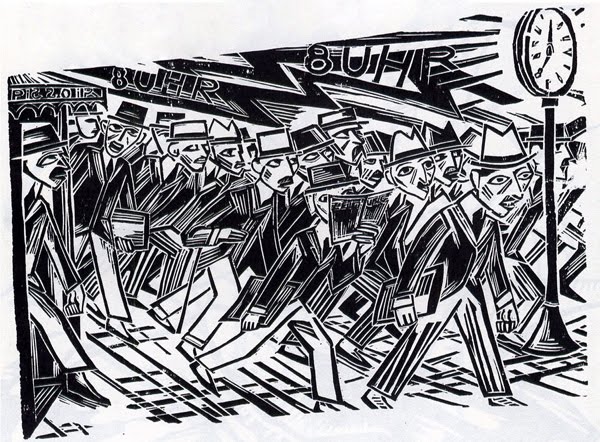![otto-dix-triptico-Metrópolis-1927-28[1]](https://cakeordeathsite.files.wordpress.com/2018/02/otto-dix-triptico-metrocc81polis-1927-281.jpg?w=656)
It was a war that the Nazi’s were bound to lose. The art produced by the various Modernists school in Germany during the period of the Weimar Republic is rightly venerated while the work of the official artists with their banal landscapes and monumental sculptures of a blandly idealised male form never rises above the level of monstrous kitsch (with the exception in the field of architecture; Albrecht Speer definitely possessed talent, but then architecture is in a certain sense fascistic, as a walk around Rome shows).
In a good illustration of Orson Welles quote in The Third Man about the chaotic warring Italian city states that produced Michelango, Da Vinci and the Renaissance, in contrast to Switzerland with its 500 year history of peace and brotherly love that has only given the world the cuckoo clock, the art of the Weimar Republic possesses its strength because of the decadence of the period, not in spite of. The calamitous defeat of Germany in WWI and the heavy reparations demanded by France and Britain, plus the use of right wing Freikorps by the Socialist government to suppress the Spartacist uprising ( see “Everyman His Own Football”) meant that Weimar Republic was unloved by both right and left. Added to the political turmoil was mass unemployment and the staggering hyper-inflation that led to frenzied consumption in the cafes, cabarets, bars and cinemas as the money in your pocket was being reduced in value by the minute. Factor in the war wounded beggars and prostitutes of both sexes lining the streets that must have resulted in the fevered, nightmarish atmosphere of a society in the midst of collapse, yet paradoxically yielding a exhilarating sense of dangerous freedom, especially sexually. Berlin attracted thrill seekers from outside of Germany who could visit one of the city’s 500 erotic venues, some of which catered exclusively to homosexuals, lesbians, transvestites and aficionados of BDSM (including the young Francis Bacon).
The main currents of art in the Weimar Republic were Expressionism, Dada and the New Objectivity. Expressionism would have a major, lasting influence on graphic design and film. Many of the artists and intellectuals who fled Nazi Germany ended up working in Hollywood where they would have an immeasurable impact upon the development of the horror and film noir genres
Below are just a few examples of the art of Weimar Republic, concentrating on the bold, innovative woodcuts of the outstanding Kathe Kollwitz; the chilling New Objectivity portraits of Otto Dix and the unsurpassed satirical savagery of George Grosz’s Ecco Homo series, as well as stills from two highly influential German Expressionist movies, Fritz Lang’s Metropolis and Robert Weine The Cabinet of Dr Caligari.
Berlin was the most decadent city of the 20th Century, as it had two periods of decadence, the Weimar Republic of the 1920’s and 30’s and then the late 70’s in West Berlin, however that is a whole other story.
![6._Portrait_of_the_Dancer_Anita_Berber_1925-compressed[1]](https://cakeordeathsite.files.wordpress.com/2018/02/6-_portrait_of_the_dancer_anita_berber_1925-compressed1.jpg?w=656)
![Otto-Dix-stormtroops-gas[1]](https://cakeordeathsite.files.wordpress.com/2018/02/otto-dix-stormtroops-gas1.jpg?w=656)
![dix-portrait-of-the-journalist-sylvia-von-harden-1926[1]](https://cakeordeathsite.files.wordpress.com/2018/02/dix-portrait-of-the-journalist-sylvia-von-harden-19261.jpg?w=656)
![dix+war+cripples[1]](https://cakeordeathsite.files.wordpress.com/2018/02/dixwarcripples1.jpg?w=656)








![cabinet_of_dr_caligari_poster_shop_new_2-1024x819[1]](https://cakeordeathsite.files.wordpress.com/2018/02/cabinet_of_dr_caligari_poster_shop_new_2-1024x8191.jpg?w=656)


Reblogged this on lampmagician.
LikeLiked by 1 person
Thank you kind sir. I have been absent a while, nice to know that I am remembered.
LikeLiked by 1 person
Of course, dear Sir, I (we) surely missed you 🙂 Great Report (y)
LikeLiked by 1 person
Thanks, I try to maintain quality. Hopefully I succeed some of the time!
LikeLiked by 1 person
Nicely written, I enjoyed it
LikeLiked by 1 person
Thank you so much, I am glad you enjoyed it. 🙃
LikeLike
I did.
LikeLiked by 1 person
Wonderful!
LikeLike
Wonderful stuff decadence!
LikeLiked by 1 person
Absolutely, one of my favourite themes here. I have written about Weimar before but I never get tired of it. Thanks for the comment.
LikeLiked by 1 person
Its also very telling that censorship (like the Nazis imposed) is often the first sign of extremism. When government try and stop freedom of expression/speech, its bad for everyone.
LikeLiked by 1 person
Always the hallmark of dictators, the press is made compliant and a channel for propaganda. The better the propaganda the nastier the dictator.
LikeLiked by 1 person
So depressing but true.
LikeLiked by 1 person
A fascinating post. And genius art pieces. Absolutely superb choices. I’m a fan of Lang, it amazes that this silent film feels completely modern. (Except maybe for the overacting, but still…)
LikeLiked by 1 person
I believe that great art at its core transcends time and place. Obviously artists are a product of their environment but if their work has resonance then the superficial trappings will not deflect from its value. Thank you, glad you enjoyed, I worked long and hard at picking the images.
LikeLiked by 2 people
Indeed, some themes are universal and timeless. I’m drawn to the Kolitz pieces. I don’t think I’ve ever seen her work before.
LikeLiked by 1 person
Her work is outstanding, raw, visceral and macabre. Very striking. You know I always aim to show the best.
LikeLike
Yes, perfect essence of Berlin decadence… Very interesting to read it in English for a change, hehe.
LikeLiked by 1 person
Thank you, well I hope I did the period justice. You know I get around in my imagination.
LikeLiked by 1 person
Ah, I’m no expert… I like it anyway… [**]
LikeLiked by 1 person
Thank you kindly I do try.
LikeLiked by 1 person
You know I’m a ‘uge fan of the period myself… Käthe Kollwitz rules. Aah, and so many more… Karl Hofer, Otto Dix, Willi Geiger, yesss.
LikeLiked by 1 person
Yes it was hard limiting it…I came to the period via Dada so I am biased towards former members of Dada.
LikeLiked by 1 person
Uh yes, hmmm, you know what that means…
LikeLiked by 1 person
That I like Berlin Dada?
LikeLiked by 1 person
Haha, yes, that, and… Have another few posts and then a book on it…
LikeLiked by 1 person
Maybe that is a good idea.
LikeLiked by 1 person
Brilliant works, I feel like the current socio-political climate of today echoes that of the doomed Weimar republic sometimes.
LikeLiked by 1 person
It does resemble sometimes, well history repeats itself, first as a tragedy then as a farce. Thank you glad you enjoyed.
LikeLike
Very interesting, true reflection of that period.
LikeLiked by 1 person
Thank you
LikeLike